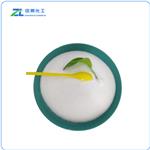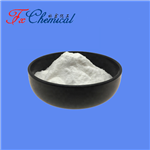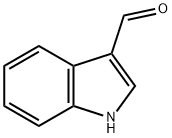Indole-3-carboxaldehyde
- CAS No.
- 487-89-8
- Chemical Name:
- Indole-3-carboxaldehyde
- Synonyms
- 1H-INDOLE-3-CARBALDEHYDE;1h-indole-3-carboxaldehyde;3-FORMYLINDOLE;INDOLE-3-ALDEHYDE;INDOLE-3-CARBOXYALDEHYDE;INDOLE-3-CARBALDEHYDE;NSC 269470;INDOL-3-ALDEHYDE;3-Indolealdehyde;Indol-3-carbaldehyde
- CBNumber:
- CB0174846
- Molecular Formula:
- C9H7NO
- Molecular Weight:
- 145.16
- MDL Number:
- MFCD00005622
- MOL File:
- 487-89-8.mol
| Melting point | 193-198 °C(lit.) |
|---|---|
| Boiling point | 264.27°C (rough estimate) |
| Density | 1.1555 (rough estimate) |
| refractive index | 1.4500 (estimate) |
| Flash point | 240 °C |
| storage temp. | Store below +30°C. |
| solubility | DMSO (Slightly), Methanol (Slightly) |
| form | Crystalline Powder |
| pka | 15.50±0.30(Predicted) |
| color | Off-white to beige-brown |
| Water Solubility | Insoluble in water. |
| Sensitive | Air Sensitive |
| BRN | 114117 |
| Stability | Hygroscopic |
| LogP | 1.680 |
| CAS DataBase Reference | 487-89-8(CAS DataBase Reference) |
| EWG's Food Scores | 1 |
| FDA UNII | 7FN04C32UO |
| NIST Chemistry Reference | 3-Indole aldehyde(487-89-8) |
| EPA Substance Registry System | 1H-Indole-3-carboxaldehyde (487-89-8) |
SAFETY
Risk and Safety Statements
| Symbol(GHS) |   GHS05,GHS07 |
|||||||||
|---|---|---|---|---|---|---|---|---|---|---|
| Signal word | Danger | |||||||||
| Hazard statements | H302-H314 | |||||||||
| Precautionary statements | P501-P260-P270-P264-P280-P303+P361+P353-P301+P330+P331-P363-P301+P312+P330-P304+P340+P310-P305+P351+P338+P310-P405 | |||||||||
| Hazard Codes | Xi | |||||||||
| Safety Statements | 22-24/25 | |||||||||
| WGK Germany | 3 | |||||||||
| RTECS | NL5993600 | |||||||||
| F | 9-23 | |||||||||
| Autoignition Temperature | >550 °C | |||||||||
| Hazard Note | Irritant/Keep Cold | |||||||||
| TSCA | Yes | |||||||||
| HazardClass | IRRITANT | |||||||||
| HS Code | 29339990 | |||||||||
| NFPA 704 |
|
Indole-3-carboxaldehyde price More Price(38)
| Manufacturer | Product number | Product description | CAS number | Packaging | Price | Updated | Buy |
|---|---|---|---|---|---|---|---|
| Sigma-Aldrich | 129445 | Indole-3-carboxaldehyde 97% | 487-89-8 | 5g | $37.1 | 2024-03-01 | Buy |
| Sigma-Aldrich | 8.04726 | Indole-3-carbaldehyde for synthesis | 487-89-8 | 25G | $100 | 2024-03-01 | Buy |
| Sigma-Aldrich | 129445 | Indole-3-carboxaldehyde 97% | 487-89-8 | 25g | $86.9 | 2024-03-01 | Buy |
| TCI Chemical | I0027 | Indole-3-carboxaldehyde >98.0%(GC) | 487-89-8 | 5g | $36 | 2024-03-01 | Buy |
| TCI Chemical | I0027 | Indole-3-carboxaldehyde >98.0%(GC) | 487-89-8 | 25g | $93 | 2024-03-01 | Buy |
Indole-3-carboxaldehyde Chemical Properties,Uses,Production
Overview
1H-Indole-3-carboxaldehyde (I3C)(1a) is a natural compound that has been found in tomato seedlings, pea seedlings, barley, lupine, cabbage, and cotton[1]. Compound 1a has been isolated from etiolated pea seedlings playing an important role as a lateral bud growth inhibitor in the apical dominance of pea seedlings[2]. Besides occurring in nature, 1a can also be obtained synthetically[3]. The Vilsmeier–Haack formylation of indole is considered to be the most applicable method for the preparation of 1H-indole-3-carboxaldehyde (1a)[4]. 1H-Indole-3-carboxaldehyde(1a) represents an important building block of many natural and synthetic biologically active compounds, especially antitumor (camalexin, coscinamides), antidepressant (α-methyltryptamine), antimicrobial (phytoalexins: brassinin and cyclobrassinin), antiviral (chondramide A), anthelmintic (chondramide C), monoamine oxidase inhibitor(aplysinopin), antiplasmodial (isocryptolepine), antifungal (phytoalexins: caulilexins A–C), DNA replication and transcription inhibitor isocryptolepine, and muscle relaxant (α,β-cyclopiazonic acid) agents (Figure 1)[5-9].
Figure 1 the chemical structure of 1H-Indole-3-carboxaldehyde
Biosynthesis
Biosynthesis of natural 1H-indole-3-carboxaldehyde was first suggested by Tang and Bonner who reported that, aldehyde[1] was produced via biotransformation of indole-3acetic acid (IAA) using crude enzyme which is prepared from etiolated pea seedlings[10]. On the other hand, brassinin oxidase (BOLm; a fungal detoxifying enzyme) mediates the conversion of the phytoalexin brassinin into 1H-indole3-carboxaldehyde with equivalent ratio[11].
Also, bacteria play an important role in the biosynthesis of it via biotransformation of L-tryptophan using Escherichia coli[12]. 1H-Indole-3-carboxaldhyde and its derivatives are not only the key intermediates for the preparation of biologically active molecules as well indole alkaloids, but also they are important precursors for the synthesis of diverse heterocyclic derivatives.
Synthesis method
Previously, 1H-indole-3-carboxaldehyde has been prepared synthetically either via direct formylation of indole using e.g., Reimer-Tiemann reaction (aq. KOH/CHCl3)[13], Grignard reaction[14], Vilsmeier Haack reaction (POCl3/DMF)[15] or formylation of the potassium salt of indole using carbon monoxide under robust conditions of heat and pressure[16]. Sommelet reaction on gramine and on indole itself oxidation of N-skatyl-N-phenyl-hydroxylamine and/or by hydrolysis of 3-(1,3-dithiolan-2-yl) indole with boron trifluoride diethyl etherate BF3.O(C2H5)2 and mercury (II) oxide HgO.
Recently, the researchers developed general and simple approaches by the use of environmentally benign reagents in order to obtain 1H-indole-3-carboxaldyhde, for an example: Unusual oxidation of graminemethiodide [1-(1H-indol-3-yl)-N, N, N-trimethylmethanaminium iodide] using sodium nitrite in N, N-dimethylformamide (DMF) produces it in 68% yield[17]. For another method: Alkaline degradation of ascorbigen leads to a mixture of L-sorbose and L-tagatose derivatives. The later ketoses underwent acetylation and open ring of pyranose using acetic anhydride in pyridine in the presence of 4-dimethylaminopyridine (DMAP) leads to a mixture, which are separated by column chromatography. Deacetylations of compounds mixture have been accompanied by the formation of end product with yield (3%)[18].
Applications for the synthesis of bioactive indole alkaloids
Indole alkaloids constitute a large class of natural products and their diverse and complex structures have been attributed to potent biological activities such as anticancer, anti-inflammatory, antimicrobial, antimalarial, antiplasmodial and protein kinase inhibition. The isolation of bioactive compounds from natural sources is difficult, costly and an extremely time-consuming process, therefore synthetic pathways are more convenient than natural separation to deliver such compounds in considerable amounts. 1H-indole-3-carboxaldehyde is an effective precursor for the synthesis of bioactive indole alkaloids utilizing 1H-indole-3-carboxaldehyde and its derivatives.
Phytoalexins
Phytoalexins are secondary metabolites formed after plants have been exposed to stressful conditions. The formed compounds constitute an important defense against pathogenic microbes[19]. The common core structure of more than 20 isolated cruciferous phytoalexins is indole possessing a side chain or a heterocycle (fused or linked) containing one or two sulfur atoms[19, 20]. More than twenty phytoalexins have been identified in the family Cruciferae, occurring in many daily used edible vegetables. Chinese cabbage (brassinin, methoxybrassinin, cyclobrassinin, and methoxybrassitin), Japanese radish (brassitin and spirobrassinin), Japanese cabbage (methoxybrassenins A and B), Japanese kohlrabi (cyclobrassinone and methoxyspirobrassinin), Japanese false flax (camalexin) and Indian mustard (brassilexin) are examples of these vegetables[19, 20].
The isolation of indole phytoalexins from cruciferous plants does not provide sufficient quantities for biological screening. Hence, synthetic methods have been elaborated to prepare sufficient quantities of indole phytoalexins including brassinin, cyclobrassinin, brassitin, cyclobrassinone, brassilexin and (S)-(–)-spirobrassinin. A key intermediate in the synthesis of indole phytoalexins is 3-aminomethylindole, which is prepared from indole-3-carboxaldehyde.
Bis(indole) Alkaloids: Rhopaladines A–D
Four bis (indole) alkaloids, rhopaladines A–D, were isolated from the Okinawan marine tunicate Rhopalaea sp. Rhopaladin B exhibited inhibitory activity against cyclindependent kinase IV and c-ErbB-2 kinase. Rhopaladin C showed antibacterial activity against Sacina lutea and Corynebacterium xerosis[21] Rhopaladines C and D were prepared starting from indole-3-carboxaldehydes.
Coscinamides A and B
Coscinamides A and B are bis (indole)-containing marine natural products that were isolated from the marine sponge Coscinoderma sp. The preparation of coscinamides A and B started with the protection of 1H-indole-3-carboxaldehyde using Roush’s method[6].
Dipodazine, Isocryptolepine and Dipodazine was isolated and characterized as a major metabolite from Penicillium dipodomyis, and subsequently from meat-associated Penicillium nalgiovese[23]. Dipodazine was synthesized via a stereoselective aldol condensation from N-protected indole-3-carboxaldehyde 1b and 1,4diacetyl-2, 5-piperazinedione in the presence of cesium carbonate[24]. Despite the absence of any biological activity expressed by dipodazine, it has several analogues reported as being active as antifouling agents[22]. Isocryptolepine, an indoloquinoline alkaloid, was isolated from the West African plant Cryptolepis sanguinolenta[25]. The total synthesis of isocryptolepine via a photo-induced cyclization was reported in 2011[25]. The reaction of 1H-indole-3-carboxaldehyde (1a) with aniline in glacial acetic acid afforded the corresponding Schiff base, which is a key step.
Carbazole Alkaloids: Mukonine and Clausine E
The 1-oxygenated carbazole alkaloids (clausine E, mukonine, and koenoline) were isolated from higher plants of the Rutaceae family. Its synthesis involved an activation and intramolecular cyclization of monoester acids that were obtained via the reaction of 1H-indole-3-carboxaldehyde (1a) with dimethyl succinate and sodium hydride in methanol (Stobbe condensation)[26].
References
- Yannai, S. Dictionary of Food Compounds with CD-ROM: Additives, Flavors, and Ingredients; CRC Press: Boca Raton, 2003.
- Nakajima, E.; Nakano, H.; Yamada, K.; Shigemori, H.; Hasegawa, K. Phytochemistry 2002, 61, 863.
- El-Sawy, E.; Abo-Salem, H.; Mandour, A. Egypt. J. Chem. 2017, 60, 723.
- Philip, N. J.; Synder, H. R. Org. Synth. 1959, 39, 30.
- Dzurilla, M.; Kutschy, P.; Zaletova, J.; Ruzinsky, M.; Kovacik, V. Molecules 2001, 6, 716.
- Kuramochi, K.; Osada, Y.; Kitahara, T. Tetrahedron 2003, 59, 9447.
- Wang, Y. Y.; Chen, C. J. Chin. Chem. Soc. 2013, 54, 1363.
- (a) González-Lamothe, R.; Mitchell, G.; Gattuso, M.; Diarra, M. S.; Malouin, F.; Bouarab, K. Int. J. Mol. Sci. 2009, 10, 3400. (b) Burnett, J. C.; Rossi, J. J. Cell Chem. Biol. 2012, 19, 60.
- Herrmann, J.; Fayad, A. A.; Mu?ller, R. Nat. Prod. Rep. 2017, 34, 135.
- Tang Y. U. and Bonner J., The enzymatic inactivation of indole acetic acid. I. Some characteristics of the enzyme contained in pea seedlings, Arch Biochemistry, 13, 25 (1947).
- Pedras M. S. C., Minic Z. and Sarma-Mamillapalle V. K., Brassinin oxidase mediated transformation of the phytoalexin brassinin: Structure of the elusive co-product, deuterium isotope effect and stereoselectivity, Bioorganic of Medicinal Chemistry,19, 1390 (2011).
- Chi-Hsinchu H.-T. (TW), US Pat20130273617A1 (2013).
- Ellinger A. and Flamand C., About synthetically Obtained tryptophan and some of its derivatives, Hoppe-Seyler's, Zeitschrift fur Physiologische Chemie, 55, 8 (1908).
- British Pat. 618, 638 (1949) (Chem. Abst., 1949,
- Philip N.J. and Synder H.R., Indole-3-carboxaldhyde, Organic Synthesis, 39, 539 (1959).
- Tyson F.J. and Shaw J.T., A new approach to 3-indolecarboxaldehyde, Journal of American Chemical Society, 74, 2273 (1952).
- Sridar V., Maheswari R. and Reddy B. S. R.,An unusual oxidation of gramine methiodides under NaNO2/DMF conditionsIndian, Indian Journal of Chemistry (Section B), 40, 1253 (2001).
- Lavrenov S. N., Korolev A. M., Reznikova M. I., Sosnov A. V. and Preobrazhenskaya M. N., Study of 1-deoxy-1-(indol-3-yl)-L-sorbose,1deoxy-1-(indol-3-yl)-L-tagatose, and their analogs, Carbohydrate Research, 338, 143 (2003).
- Pedras, M. S. C.; Nycholat, C. M.; Montaut, S.; Xu, Y.; Khan, A. Q. Phytochemistry 2002, 59, 611.
- Pedras, M. S. C.; Yaya, E. E.; Glawischnig, E. Nat. Prod. Rep. 2011, 28, 1381.
- Janosik, T.; Johnson, A.-L.; Bergman, J. Tetrahedron 2002, 58, 2813.
- Kumar, R. N.; Suresh, T.; Mohan, P. S. Tetrahedron Lett. 2002, 43, 3327.
- Johnson, A.-L.; Janosik, T.; Bergman, J. ARKIVOC 2002, (viii), 57.
- Sjögren, M.; Johnson, A.-L.; Hedner, E.; Dahlström, M.; Göransson, U.; Shirani, H.; Bergman, J.; Jonsson, P. R.; Bohlin, L. Peptides 2006, 27, 2058.
- Hingane, D. G.; Kusurkar, R. S. Tetrahedron Lett. 2011, 52, 3686
- Budovská, M.; Kutschy, P.; Ko?ár, T.; Gondová, T.; Petrovaj, J. Tetrahedron 2013, 69, 1092.
Chemical Properties
?Indole-3-aldehyde [487-89-8], C9H7NO, Mr 145.16, mp 194 ℃, forms colorless crystals. It is readily soluble in ethanol and slightly soluble in cold water. It can be produced by Vilsmeier reaction of indole with formylmethylaniline or with dimethylformamide and phosphorus oxychloride. Indole-3-aldehyde can be used to make D,L-tryptophan and cyanine dyes.
Uses
Indole-3-carboxaldehyde is a biochemical used to prepare analogs of the indole phytoalexin cyclobrassinin with NR1R2 group. It was also used as the starting material for the synthesis of higher order indoles including isoindolo[2,1-a]indoles, aplysinopsins, and 4-substituted-tetrahydrobenz[cd]indoles.
Definition
ChEBI: A heteroarenecarbaldehyde that is indole in which the hydrogen at position 3 has been replaced by a formyl group.
Synthesis Reference(s)
Journal of the American Chemical Society, 68, p. 1156, 1946 DOI: 10.1021/ja01211a006
The Journal of Organic Chemistry, 60, p. 7272, 1995 DOI: 10.1021/jo00127a036
Organic Syntheses, Coll. Vol. 4, p. 539, 1963
General Description
Indole-3-carboxaldehyde can undergo Schiff bases condensation to form multifunctional silica nano-vehicles and magnetic nanoparticles.
Indole-3-carboxaldehyde Preparation Products And Raw materials
Raw materials
1of2
Preparation Products
1of2
| Supplier | Tel | Country | ProdList | Advantage | |
|---|---|---|---|---|---|
| Changzhou Jiuwu Chemical co., Ltd. | +86-0519-85121086 +8613775162768 | info@jiuwuchem.cn | China | 77 | 58 |
| Hebei Weibang Biotechnology Co., Ltd | +8615531157085 | abby@weibangbio.com | China | 8812 | 58 |
| Hebei Chuanghai Biotechnology Co,.LTD | +86-13131129325 | sales1@chuanghaibio.com | China | 5893 | 58 |
| Hebei Weibang Biotechnology Co., Ltd | +8617732866630 | bess@weibangbio.com | China | 18154 | 58 |
| Henan Fengda Chemical Co., Ltd | +86-371-86557731 +86-13613820652 | info@fdachem.com | China | 20287 | 58 |
| BINBO BIOLOGICAL CO.,LTD | +8618629063126 | info@binbobiological.com | China | 377 | 58 |
| Hebei Zhuanglai Chemical Trading Co.,Ltd | +8613343047651 | admin@zlchemi.com | China | 3002 | 58 |
| Henan Tianfu Chemical Co.,Ltd. | +86-0371-55170693 +86-19937530512 | info@tianfuchem.com | China | 21634 | 55 |
| career henan chemical co | +86-0371-86658258 +8613203830695 | sales@coreychem.com | China | 29884 | 58 |
| NINGBO INNO PHARMCHEM CO., LTD. | 13867897135 | sales@nbinno.com | CHINA | 923 | 58 |
View Lastest Price from Indole-3-carboxaldehyde manufacturers
| Image | Update time | Product | Price | Min. Order | Purity | Supply Ability | Manufacturer | |
|---|---|---|---|---|---|---|---|---|
 |
2024-11-22 | Indole-3-Carboxaldehyde
487-89-8
|
US $75.00-20.00 / kg | 1kg | 99% | 20ton | Hebei Zhuanglai Chemical Trading Co.,Ltd | |
 |
2024-11-22 | Indole-3-carboxaldehyde
487-89-8
|
US $0.00-0.00 / Kg/Drum | 1KG | 98%min | 1000kg | WUHAN FORTUNA CHEMICAL CO., LTD | |
 |
2024-11-20 | Indole-3-carboxaldehyde
487-89-8
|
US $10.00 / KG | 1KG | 99% | 10 mt | Hebei Weibang Biotechnology Co., Ltd |
-

- Indole-3-Carboxaldehyde
487-89-8
- US $75.00-20.00 / kg
- 99%
- Hebei Zhuanglai Chemical Trading Co.,Ltd
-

- Indole-3-carboxaldehyde
487-89-8
- US $0.00-0.00 / Kg/Drum
- 98%min
- WUHAN FORTUNA CHEMICAL CO., LTD
-

- Indole-3-carboxaldehyde
487-89-8
- US $10.00 / KG
- 99%
- Hebei Weibang Biotechnology Co., Ltd





